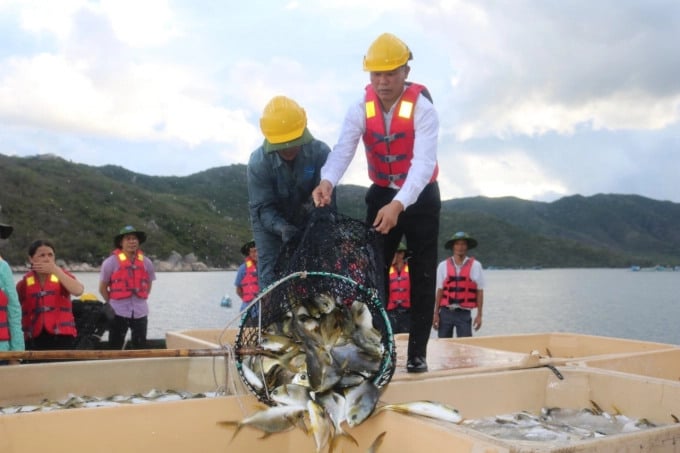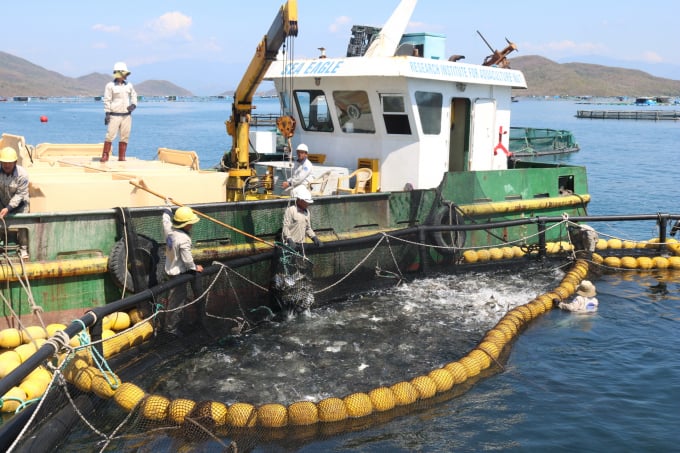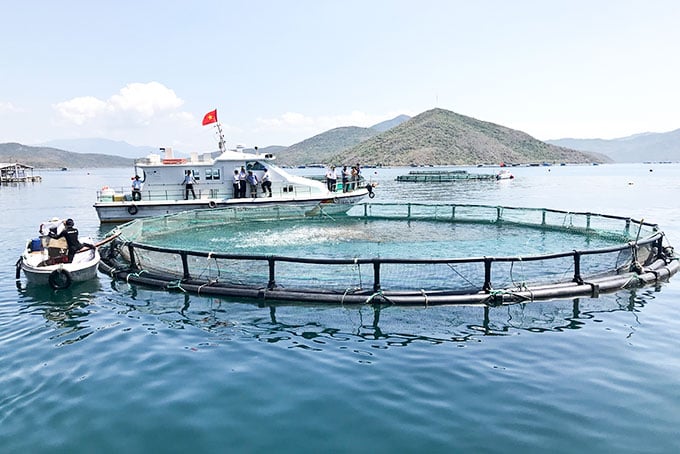May 29, 2025 | 16:04 GMT +7
May 29, 2025 | 16:04 GMT +7
Hotline: 0913.378.918
May 29, 2025 | 16:04 GMT +7
Hotline: 0913.378.918
On October 4, 2021, the Prime Minister issued Decision 1664/QD-TTg approving the Project on Development of Marine Aquaculture to 2030, with a vision to 2045. The project aims to develop marine aquaculture into a large-scale, industrial, synchronous, safe, efficient, sustainable commodity production industry protecting the ecological environment.
The fishery industry is creating branded products, meeting the demands of domestic markets and exports, creating jobs, improving socio-economic conditions, raising incomes for coastal communities, and contributing to protecting the security and defense of the country's seas and islands.

Deputy Minister of Agriculture and Rural Development Phung Duc Tien (right) visits a Norwegian-style sea cage fish farm on Van Phong Bay, Khanh Hoa Province. Photo: KS.
Accordingly, by 2025, the project will help increase the marine aquaculture area to 280,000 with a cage volume of 10 million cubic meters and output reaching 850,000 tons. In which, inshore marine farming is expected to cover 270,000 ha of seawater surface with a cage volume of 8 million cu.m and output of 750,000 tons. Offshore marine farming is also expected to cover 10,000 ha with a cage volume of 2 million cu.m and an output of 100,000 tons. The value of export turnover will reach USD0.8 - 1 billion.
By 2030, the marine aquaculture area is expected to reach 300,000 hectares with a cage volume of 12 million cu.m and an output of more than 1.4 million tons. In which, inshore marine aquaculture is 270,000 ha with a cage volume of 8.5 million cu.m and output reaching more than 1.1 million tons. Offshore marine farming is expected to cover 30,000 ha of the sea surface with a cage volume of 3.5 million cu.m and an output of 340,000 tons. Export turnover thus will reach USD1.8-2 billion.
With a vision to 2045, our country's marine aquaculture industry will reach an advanced level of modern management methods becoming an important part of the seafood industry, contributing over 25% to the total output and export value of over USD4 billion.
On that basis, the Project is focusing on the following development contents: scientific and technological applications, service infrastructure system, breed and feed production, sustainable marine aquaculture, marine aquaculture processing, and trade.

The Project sets a target that by 2025, the marine aquaculture area will reach 280,000 hectares with a cage volume of 10 million cu.m, and an output of 850,000 tons. Photo: TL.
As part of the master project, groups of investment and research sub-projects including those of technical infrastructure and a pilot group of industrial-scale mariculture in the period of 2021 - 2025 will be implemented in Quang Ninh, Phu Yen, Ninh Thuan, and Kien Giang. The group of sub-projects on investment in offshore and concentrated service infrastructure will be carried out in Quang Ninh, Ninh Thuan, Khanh Hoa, Phu Yen, and Kien Giang.
The group of projects to invest in breed production infrastructure includes mollusk in Quang Ninh, clam in Nam Dinh and Thai Binh, oysters in Ninh Binh, seaweed and ornamental creatures in Khanh Hoa, Ninh Thuan and Binh Thuan, and sea fish in Kien Giang.
According to the project, on the development of near-shore marine aquaculture, priority is given to the development of species with high market competitive advantages and values such as marine fish, crustaceans, mollusk, and seaweed.
The Project focuses on industrial farming methods with priorities given to the development of multi-species growing models suitable for each ecological and environmental area associated with resource protection, development, and co-management.
For the provinces and cities from Quang Ninh to Ninh Binh, the Project clearly states that it will continue to build the Hai Phong - Quang Ninh area into a center for marine aquaculture, associated with a large fishery centers; focus on marine aquaculture development in the provinces associated with marine conservation and national tourism. It will also build concentrated mollusk breed production areas to meet the in the region and the whole country.
The group of projects on science and technology will serve all stages in the marine aquaculture chain, including those on research and application of new technologies in offshore mariculture, breed research and development and seaweed growing for exports by 2030.
The group of projects on marine aquaculture management includes those on investigation and assessment of the current mariculture situation in the country, identification of potential areas for marine aquaculture development, environmental monitoring and warning, disease prevention, and management capacity enhancement.

Key provinces such as Quang Ninh, Hai Phong, Quang Ngai, Phu Yen, Khanh Hoa, Ninh Thuan, Binh Thuan, Ba Ria - Vung Tau, Ca Mau and Kien Giang and some localities with favorable natural conditions will build offshore marine farming areas. Photo: NNVN.
For provinces and cities from Thanh Hoa to Binh Thuan, marine aquaculture development will be associated with seafood processing, logistics services, and infrastructure. The Project also targets building and operating an effective and sustainable co-management model for lobster exploitation.
For provinces and cities from Ba Ria - Vung Tau to Kien Giang, it will focus on building and developing marine aquaculture in localities with favorable conditions, harmoniously linking marine farming with marine eco-tourism services, oil and gas industry, wind power production.
In the development of the offshore marine aquaculture industry, the Project determines that there will be strong focus on developing species with high competitive and consumption advantages in large markets such as fish and molluscs with high economic values.
It aims to develop the industrial, modern, large-scale aquaculture, ensuring food safety, protecting the ecological environment and adapting to climate change. It promotes using cage and raft systems with structures and materials suitable for each species so that to be resistant to weather changes such as big waves, high winds and heavy storms.
The Project targets to form offshore aquaculture zones in key provinces such as Quang Ninh, Hai Phong, Quang Ngai, Phu Yen, Khanh Hoa, Ninh Thuan, Binh Thuan, Ba Ria - Vung Tau, Ca Mau, Kien Giang and some other locations with favorable natural conditions.
Translated by Linh Nguyen
/2025/05/25/4127-3-073637_820.jpg)
(VAN) Thanks to the promotion from an FAO-implemented project, vegetable production in greenhouses in Moc Chau has seen strong development, from 1.5 hectares in 2021 to nearly 50 hectares in 2024.

(VAN) FAO has recently supported USD 140,000 to implement the project 'Risk mitigation human-animal interface risks through disease control initiatives in pig farming.'

(VAN) The People's Committee of Tra Vinh province has approved an adjustment to the investment policy for the Green Hydrogen Plant project, increasing its area to approximately 52.76 hectares.
![Reducing emissions from rice fields: [2] Farmers’ commitment to the soil](https://t.ex-cdn.com/nongnghiepmoitruong.vn/608w/files/news/2025/05/05/dsc08881jpg-nongnghiep-140632.jpg)
(VAN) Clean rice cultivation model in Thuong Tan commune, Bac Tan Uyen district, is assisting local residents in achieving sustainable agriculture by substantially reducing costs, increasing productivity, and protecting the environment.

(VAN) At the conference to disseminate Resolution No. 68, AgriS introduced its digital agricultural ecosystem and reaffirmed its commitment to accompanying the Government in promoting private sector development and sustainable agriculture.

(VAN) 'Blue Ocean - Blue Foods' initiative is designed to restore marine ecosystems and establish sustainable livelihoods for local communities by cultivating a minimum of 1,000 hectares of cottonii seaweed in the first three years.
/2025/05/21/4642-3-112707_603.jpg)
(VAN) The V-SCOPE project has made direct contributions to three out of six pillars of the Comprehensive Strategic Partnership between Vietnam and Australia.